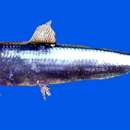Diagnostic Description
provided by Fishbase
Diagnosis: Body slender, its depth 18 to 30% of standard length; presence of two fleshy outgrowths on the hind margin of the gill opening; sharp belly with keeled scutes, 16-19 pre-pelvic and 12-14 post-pelvic scutes (Ref. 188, 3259). The presence of elongate wing-like scales underneath the normal paired pre-dorsal scales separate it from all other species except the two Australian species with prominent black spots on the flank, Herklotsichthys koningsbergeri and Herklotsichthys Species A, and the unspotted Herklotsichthys Species B, which has dusky tips to dorsal and caudal fins and more lower gill rakers, 36-42 vs. 33-36 in H. quadrimaculatus (Ref. 188). Flank silvery with an electric blue line preceded by two orange spots (Ref. 188).Description: Body fusiform, moderately slender; depth of body 3.1-3.9 in standard length (Ref. 3107, 90102). Top of head with few, fronto-parietal striae, about 4-7 striae on each side (Ref. 3259). Lower portion of paddle-shaped second supramaxilla longer than upper; gill opening with two fleshy outgrowths; no prominent ridges of teeth on roof of mouth (Ref. 3107, 3259). Lower gill rakers 28-37; upper gill rakers 11-16; total gill rakers 40-50 (Ref. 3259, 122993). Dorsal fin with 3-5 unbranched and 13-16 branched rays; anal fin with 2-4 unbranched and 13-17 branched rays; pectoral fin with 1 unbranched and 13-16 branched rays; pelvic fin with 1 unbranched and 7 branched rays (Ref. 3259, 122993). Longitudinal scale series 38-45; broad wing-like scales almost hidden beneath the overlapping pre-dorsal scales (Ref. 3107, 3259, 30573, 122993). Sharp belly, with keeled scutes; total ventral scutes 30-32, with 16-19 pre-pelvic and 12-14 post-pelvic scutes (Ref. 3259, 90102, 122993).Colouration: Back blue-green without spots, flanks silvery with two orange spots behind gill opening in life and a blue midlateral band (Ref. 188, 3107, 3259).
- Recorder
- Crispina B. Binohlan
Life Cycle
provided by Fishbase
Oviparous (Ref. 205). Breeds during its first year and probably survives only a few months after maturity (Ref. 188).
- Recorder
- Crispina B. Binohlan
Morphology
provided by Fishbase
Dorsal spines (total): 0; Dorsal soft rays (total): 16 - 23; Analspines: 0; Analsoft rays: 15 - 21
- Recorder
- Crispina B. Binohlan
Trophic Strategy
provided by Fishbase
Present in seagrass beds at adult stage (Ref. 41878). Forms large schools in shallow water during the day. Moves into deeper water and further offshore at night. Is a nocturnal zooplanktivore (Ref. 9004). At no time is phytoplankton taken.
- Recorder
- Crispina B. Binohlan
Biology
provided by Fishbase
Adults form schools near mangroves, shallow coastal bays and lagoons during the day and moves further offshore into deeper water by night (Ref. 188, 48635); at depths of 0-13m (Ref. 58302, 82332). Known in mills around in large schools under wharves or along sandy beaches in protected bays (Ref. 26367). Pelagic (Ref. 58302). Feeds on zooplankton, mainly at night, chiefly copepods in juvenile stages, but larger prey as adults (chaetognaths, polychaetes, shrimps and small fishes) (Ref. 188). Breeds during its first year and probably survives only a few months after maturity (Ref. 188). Marketed fresh and dried salted (Ref. 188). Usually parceled in leaves and baked in a motu oven. Do not recover quite as quickly as other species of baitfish after heavy fishing (Ref. 26367).
- Recorder
- Crispina B. Binohlan
Importance
provided by Fishbase
fisheries: minor commercial; bait: usually; price category: low; price reliability: reliable: based on ex-vessel price for this species
- Recorder
- Crispina B. Binohlan
分布
provided by The Fish Database of Taiwan
分布於印度-西太平洋區,西起非洲東岸,東至夏威夷,北至日本、臺灣,南至澳洲。臺灣分布於南部、西部、北部及澎湖海域。
利用
provided by The Fish Database of Taiwan
產量不高之次經濟性魚種。主要漁法為流刺網、拖網與圍網。一般多醃漬後出售,生鮮時可適合煎炸後食用,或做為延繩釣之釣餌。
描述
provided by The Fish Database of Taiwan
體延長而側扁,腹部略圓,具稜鱗,16+
12個。脂性眼瞼發達。口小,端位;上下頜約等長;前上頜骨中間無缺口;上頜骨末端達眼前緣下方。鰓蓋光滑;鰓裂內後緣具2乳突。額頂細紋少,僅3-7條。體被細薄圓鱗,極易脫落;鱗片上之垂直條紋不中斷;背鰭和臀鰭基部之鱗鞘低;胸鰭和腹鰭基部具腋鱗。背鰭位於體中部前方,具軟條16;臀鰭位於體之後半部,具軟條15;腹鰭軟條8;尾鰭深叉。體背部青綠色,體側下方和腹部銀白色;體背兩側無點狀條紋。背鰭淡黃,前端基部不具黑點;尾鰭淡黃,上下葉不具黑緣,且末端不具大塊黑斑;胸鰭淡黃;餘鰭淡色。
棲地
provided by The Fish Database of Taiwan
沿近海表層洄游性中小型魚類,有時會進入內灣或潟湖區內。群游性。以浮游生物為食。
Herklotsichthys quadrimaculatus
provided by wikipedia EN
Herklotsichthys quadrimaculatus, also known as the bluestripe herring, is a species of ray-finned fish in the family Clupeidae.[2] It is widespread in the Indian Ocean and the western Pacific Ocean.[1][2] Other names for the species include goldspot sardine and fourspot herring.[3] It can grow to a maximum standard length 25 cm (9.8 in), although its typical length is less than half of that.[2]
References
-
^ a b Santos, M.; Deligero, R.; Alcantara, M.; Doyola, M.C.; Gatlabayan, L.V.; Villarao, M.C.; Tambihasan, A.M.; Lopez, G.; Villanueva, J.A.; Buccat, F.G.A.; Parido, L.; Lanzuela, N.; Belga, P.B.; Gapuz, A.V. (2017). "Herklotsichthys quadrimaculatus". IUCN Red List of Threatened Species. 2017: e.T57506640A58341331. doi:10.2305/IUCN.UK.2017-3.RLTS.T57506640A58341331.en. Retrieved 19 November 2021.
-
^ a b c Froese, Rainer; Pauly, Daniel (eds.) (2019). "Herklotsichthys quadrimaculatus" in FishBase. December 2019 version.
-
^ "Goldspot herring (Herklotsichthys quadrimaculatus) - Species Profile".
- Pamela J. Schofield. 2017. Herklotsichthys quadrimaculatus. USGS Nonindigenous Aquatic Species Database, Gainesville, FL.

- license
- cc-by-sa-3.0
- copyright
- Wikipedia authors and editors
Herklotsichthys quadrimaculatus: Brief Summary
provided by wikipedia EN
Herklotsichthys quadrimaculatus, also known as the bluestripe herring, is a species of ray-finned fish in the family Clupeidae. It is widespread in the Indian Ocean and the western Pacific Ocean. Other names for the species include goldspot sardine and fourspot herring. It can grow to a maximum standard length 25 cm (9.8 in), although its typical length is less than half of that.
- license
- cc-by-sa-3.0
- copyright
- Wikipedia authors and editors
Description
provided by World Register of Marine Species
Forms schools near mangroves, shallow coastal bays and lagoons during the day and moves further offshore into deeper water by night. Feeding occurs mainly at night on zooplankton, chiefly copepods by juveniles, and as adults, on larger prey organisms (chaetognaths, polychaetes, shrimps and small fishes). Breeds during its first year and probably survives only a few months after maturity. Marketed fresh and dried salted.
Froese, R. & D. Pauly (Editors). (2023). FishBase. World Wide Web electronic publication. version (02/2023).
- license
- cc-by-4.0
- copyright
- WoRMS Editorial Board

